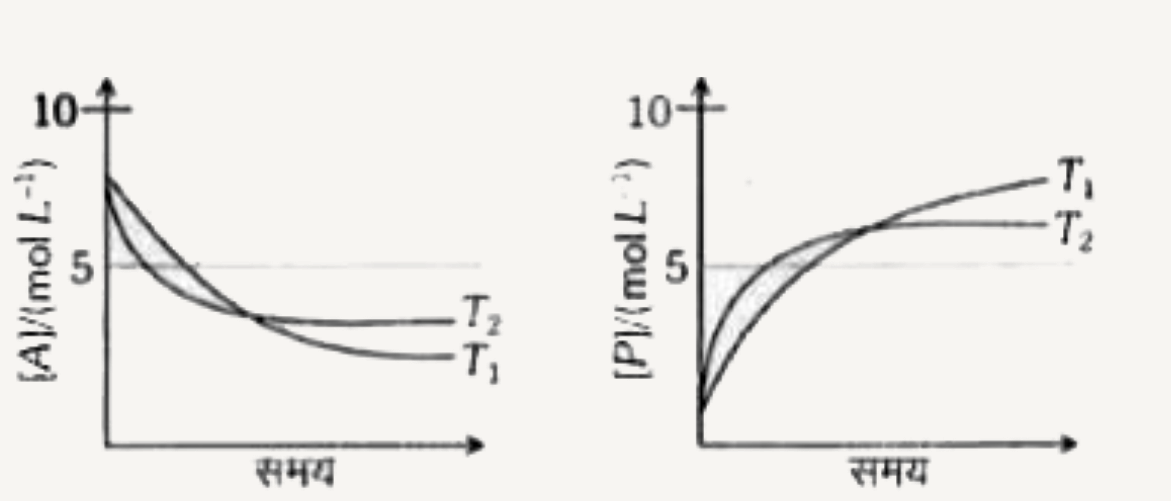The temperature coefficient of a reaction is 2.5 . If its rate constant at T1K is 2.5×10−3s−1, the rate constant at T2K in s−1 is (T2>T1)Solution in Telugu
1.0×10−3
6.25×10−3
1.0×10−2
6.25×10−2
The correct Answer is:B
Step by step video, text & image solution for The temperature coefficient of a reaction is 2.5 . If its rate constant at T_(1)K is 2.5xx10^(-3)s^(-1), the rate constant at T_(2)K in s^(-1) is (T_(2)gtT_(1)) by Chemistry experts to help you in doubts & scoring excellent marks in Class 12 exams.
Updated on:21/07/2023Topper's Solved these Questions
- CHEMICAL KINETICSBOOK - AAKASH SERIESCHAPTER - CHEMICAL KINETICSEXERCISE - Example
32 Videos
- CHEMICAL KINETICSBOOK - AAKASH SERIESCHAPTER - CHEMICAL KINETICSEXERCISE - Subjective Exercise-I(Long answer question)
1 Videos
- CHEMICAL KINETICSBOOK - AAKASH SERIESCHAPTER - CHEMICAL KINETICSEXERCISE - OBJECTIVE EXERCISE - 2 (Order, molecularity, Half life)
38 Videos
- CHEMICAL KINETCSBOOK - AAKASH SERIESCHAPTER - CHEMICAL KINETCSEXERCISE - EXERCISE - 3.2
45 Videos
- CHEMICAL THERMODYNAMICSBOOK - AAKASH SERIESCHAPTER - CHEMICAL THERMODYNAMICSEXERCISE - Additional Practice Exercise
54 Videos
Similar Questions
Formation of water from its elements is spontaneous, but is slow. Comment .
View SolutionDefine rate of chemical reaction and explain the factors that effect the rate of reaction.
View SolutionSucrose decompose in acid solution into glucose and fructose according to the first order rate law, with t12=3.00 hours. What fraction of sample of sucrose remains after 8 hours ?
View SolutionDiscuss on the kinetic spontaneity of a chemical reaction. Is a slow reaction spontaneous? Why?
View SolutionWhich among the following is not an exact differential?
View SolutionA rod of length L with sides fully insulated is made of a material whose thermal conductivity K varies with temperature as K=αT where α is constant. The ends of rod are at temperature T1 and T2(T2>T1) Find the rate of heat flow per unit area of rod .
View SolutionIf the rate constant of a first order reaction at a certain temperature is 1.5xx10^(-1)s^(-1) and t_(1) and t_(2) are the respective times for 50% and 75% completion of the reaction, determine the ratio of t_(2)" to "t_(1) .
View SolutionHow is half-life period (t_(1//2)) of a first order reaction related to its rate constant (k) ?
View SolutionIf K_(1) is equilibrium constant at temperature T_(1) and K_(2) is the equilibrium constant at temperature T_(2) , and if T_(2)gtT_(1) and reaction is endothermic then
View SolutionThe rate constant and half-life of a first order reaction at temperature T1 are k1min−1andx1min , respectively and those at temperature T2 are k2min−1andx2 min , respectively. If T2>T1 , which is greater , x1 or, x2 ?
View SolutionEffect of temperature of equilibrium constant is given by logK_(2)-logK_(1)=(-DeltaH)/(2.303R)[(1)/(T_(2))-(1)/(T_(1))](" where "T_(2)gtT_(1)) . Then for a endothermic reaction the false statement is
View Solutionअभिक्रिया, A⇔P के लिए, [A] और [P] के समय के साथ तापमान T1 और T2 पर आलेख नीचे दिए गए हैं।

यदि T2>T1 तो सही प्रकथन है (हैं)
(ΔHθ और ΔSθ को तापमान निर्भरता से स्वतंत्र मानिये और T1 पर In(K) तथा T2 पर In(K) का अनुपात T2/T1 से अधिक है। यहाँ H,S,G और K, क्रमशः एन्थैल्पी, एन्ट्रापी, गिब्ज, ऊर्जा और साम्यावस्था स्थिरांक हैं।)
View Solutionऊष्माक्षेपी अभिक्रिया के लिए तापमान T1 एवं T2 पर साम्यावस्था स्थिरांक क्रमशः Kp और K'p हैं, यदि यह मान लिया जाए कि तापमान सीमा T1 एवं T2 के बीच अभिक्रिया की ऊष्मा स्थिर है | तो आसानी से प्रेक्षित है
View SolutionIf k1 and k2 are rate constants at temperatures T1 and T2 respectively then according to Arrhenius equation :
View SolutionThe area of triangle formed by the points points and t1,t2 and t3 on y3 =4ax is k|(t1−t2)(t2−t3)(t3−t1)| then K =
View Solution
